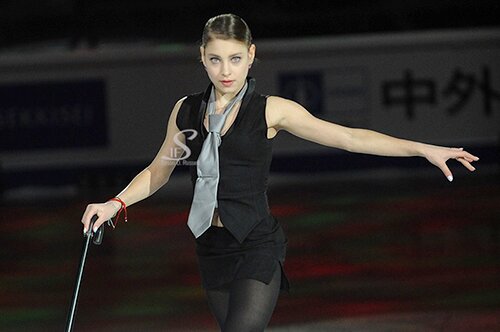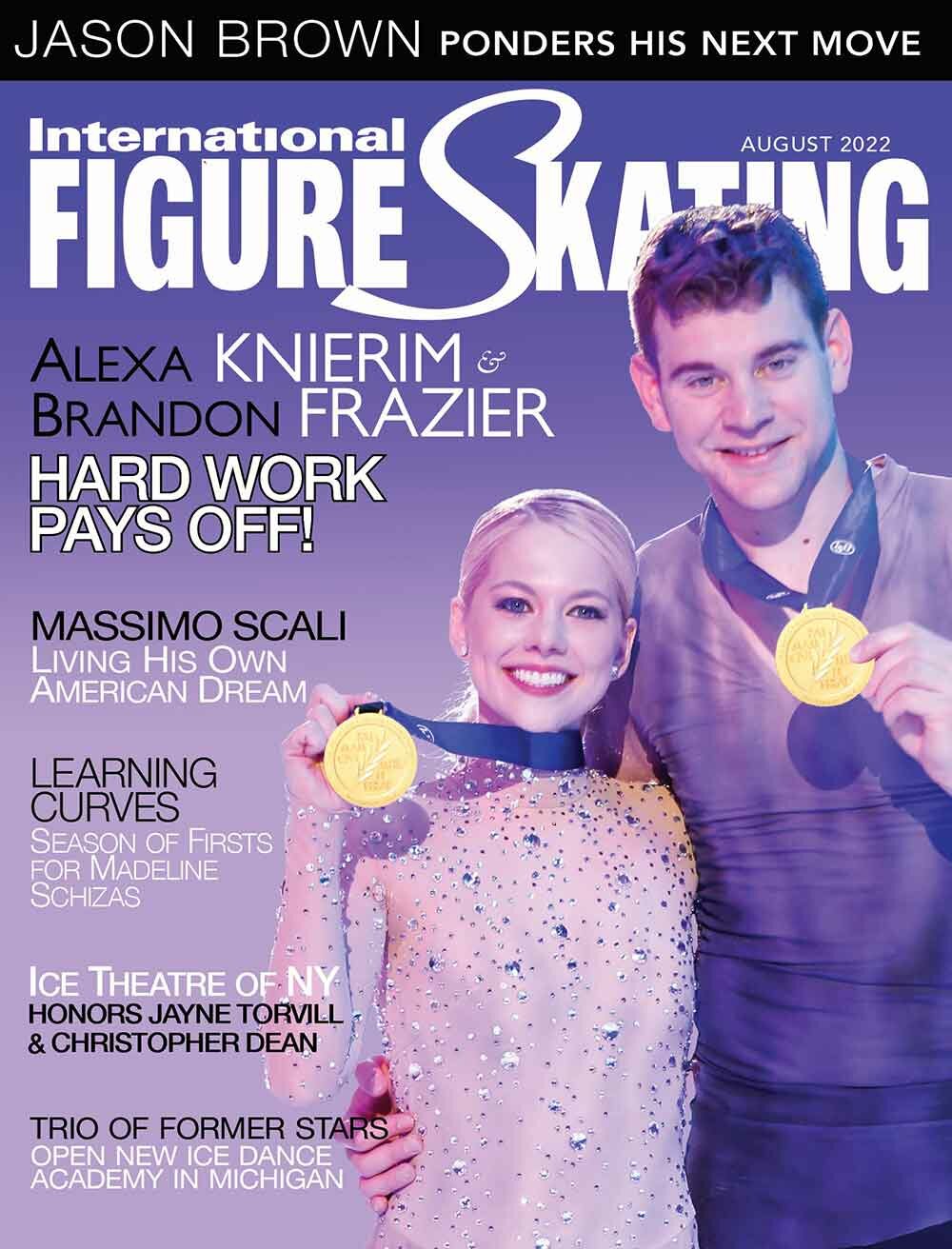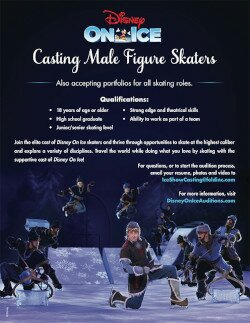

She could not have written a better script for her debut on the senior circuit last season.
Though no one knew it at the time, when Alena Kostornaia scored a runaway victory at Finlandia Trophy in early October, it was a sign of things to come. A decisive win at her first competition on the senior Grand Prix circuit (Internationaux de France) was followed by a third consecutive triumph at NHK Trophy three weeks later.
Kostornaia closed out 2019 by claiming the Grand Prix Final crown in Torino, Italy. The 16-year-old opened 2020 with a second-place finish at the Russian Championships in late December, and a month later led a Russian sweep of the ladies podium at the European Championships in Graz, Austria. What made all of this so surprising is that last season was the opposite of what transpired throughout her junior career. Sitting in the shadows of Alexandra Trusova, Kostornaia won just one major competition (the 2018 Junior Grand Prix Final) over her training mates, Trusova and Anna Shcherbakova.
Kostornaia was scheduled to close out her junior career at the 2019 World Junior Championships but was forced to withdraw because of a leg injury. She turned her attention to preparing for her debut at the senior level last season, and though she was excited about making that leap, she admitted initially it was a little daunting.
At the Russian test skates in the fall of 2019, Kostornaia began questioning herself and her abilities as both Shcherbakova and Trusova had quads in their arsenals and she did not. It seemed Kostornaia would not have the technical package to make a splash in her debut on the senior scene, as her teammates seemed set to do. “I was upset because I didn’t skate my program perfectly. I made errors and I was feeling down,” Kostornaia recalled. “After the test skates I realized that I needed to change something and I decided to try the quad Salchow. I tried it for a few days and then Daria Pavliuchenko (a pairs skater who is her best friend) helped me a lot by telling me that I could do it. She said, ‘you need to change something. You can do it. Everything will work out.’”
Kostornaia had learned the triple Axel in 2017 and was eager to include it in her programs at that time, but a growth spurt caused her to lose the jump. “It took a long time to get the triple Axel and I did the element clean. It was upsetting because I learned it and then lost it and couldn’t get it back,” she explained, adding that the fear of getting injured also played a part. “When I returned to training, Sergei Rozanov (one of the coaches who works with Eteri Tutberidze) said, ‘let’s try the Axel again.’”
A month after the test skates, Kostornaia landed her first triple Axel in the free skate at Finlandia Trophy. It has ultimately become the weapon she needed in the battle with her teammates. “The jump is still a bit difficult. Mentally it is harder to do, but physically it is easier,” she said. “I cannot say that it is one that I can do with my eyes closed. It demands concentration and I need to pay attention to keep my edges right and to understand what I’m doing. When I go into a jump the correct way, especially the Axel, it always works. As for the other jumps that I have been doing for a long time in my programs, my muscles naturally know what to do and when I’m in the air, I’m resting.”
But as we saw last season, the Moscow teenager is about more than just jumps. She consistently earns high Grade of Execution scores for her skating skills, artistry, expression, and the interpretation of her well-choreographed programs. Many have described her as the “complete package.”
Kostornaia’s golden streak ended at the Russian Championships in late December when Shcherbakova narrowly defeated her. That result made Kostornaia conscious of the fact that she needed to approach practice sessions with more attention, to train a little more seriously and be more disciplined. Kostornaia also understands the need to learn new elements, upgrade the difficulty of her programs and to skate clean.
In the early days of 2020, Kostornaia performed in a show in Italy, before taking a short vacation. Her second-place finish at Russian nationals had guaranteed her a trip to the European Championships in late January. When Kostornaia returned to her training base in Moscow it was with renewed enthusiasm to prepare for this important competition.
As with all her senior events in the 2019-2020 campaign, Kostornaia was excited about the opportunity. “Everything was kind of new and I didn’t know what to expect,” she said. “It was a feeling of something unknown because I did not know how it would be and that made it twice as interesting.
“There is a big difference between what I did the season before and this one. First of all, I was used to traveling in a team where everyone was about the same age as me. But now, most of the skaters are older than me and are more grown up. Last year I was watching these athletes on TV and now I am sitting with them in the same dressing room, and I am with them on the podium. Just to be with these high-level athletes is a joy.”
It was almost a given heading into the 2020 European Championships that the “A Team” (Kostornaia, Shcherbakova and Trusova) would dominate the ladies field — but which one would emerge the victor was the question everyone was asking.
The trio of European debutantes lived up to their billing in Graz, placing top three in the short program led by Kostornaia — the only lady to attempt a triple Axel in the field of 35 — who soared to the top of the standings with a 6.97-point cushion heading into the free skate.
Although she landed all the elements in the short, Kostornaia was not satisfied with the performance. “I would love to improve with every competition but it seems I went down,” she said with respect to a score that was slightly lower than the one she achieved at the Grand Prix Final.
The last skater of the night, Kostornaia sailed through her long program with ease until the final jumping pass. A slight hesitation heading into a triple Lutz caused a momentary loss of focus, and she tumbled to the ice. However, the artistic presentation that complemented every element Kostornaia executed — including the spins and footwork sequence — made that one mistake inconsequential. She finished second in the free behind Shcherbakova but held on to win by a 3.05-point margin.
“I was just really happy that I was there at all and that I ended up on the podium,” said Kostornaia. “When I went to that competition, I didn’t think about my chances to win, I just wanted to give decent performances. It was a big honor for me to represent my country at the European Championships in my first senior year. It was just great and I’m very happy about it.” Addressing the criticism some have expressed about the level of technical content the ladies are now including in their programs, Kostornaia said, “I think every athlete wants to be the best, to do something first. Anna and Sasha are competing to do ‘firsts.’ I just try to skate as clean as possible. “Figure skating develops so fast now, and if previously the ladies were skating until 25 … for sure now the younger girls are rising to the top. Unfortunately, the careers are shorter because of the elements that adults probably physically can’t do. There is always a generation that will overtake the present one.”
Training in what is probably the strongest, toughest group in the world is inspiring for Kostornaia, who said that watching Trusova land “three, four or five quads” is very motivating for her. “I watch that from the boards and think, ‘I do all the triples, but Sasha is jumping and jumping and Anna is also jumping. Obviously, it is upsetting when everyone is doing that and you are not. So I’m trying to improve and perfect myself so that this difference is not that obvious.”
Kostornaia said all three spend a lot of time together in training and at competitions and “hang out together sometimes off the ice. We can talk about all kinds of topics and one thing leads to the next. We can discuss figure skating and after three minutes we can talk about a new modern dance.”
Coach Daniil Gleikhengauz said the next step for Kostornaia is the quad Salchow. She has attempted the jump in training but has yet to fully rotate and land one. “It is still a very raw jump that I needed to learn from scratch, but my trajectory is quite even, so there is a chance for me to do it,” Kostornaia explained.
Like most teenagers, the many ideas and plans she has for her future frequently change. At one point she said she indicated a desire to study neurosurgery, but she has since abandoned the idea of studying medicine. “I realized that if I want to compete and to win it will be hard to combine that with studies. Therefore, I’ve put that aside for the moment. I’m actually interested in becoming a TV sports journalist now,” she said.
Away from the ice, Kostornaia enjoys horseback riding, and during the off-season is learning dressage and show jumping. She spent her day off at the European Championships in Graz visiting a stud farm that breeds the famous Lipizzaner horses.
“During the summer, we went on vacation and chose a hotel where there was horse riding, but right now I’m not doing that as it is the time for serious competitions. It is dangerous after all. My aunt has a horse, so I can call her anytime and ask if I can come over. I’m doing more dressage for now — this is elementary — and I have been trying show jumping.
“It’s like when you first learn to skate and then learn how to jump.
(Originally published in the IFS April 2020 issue)




